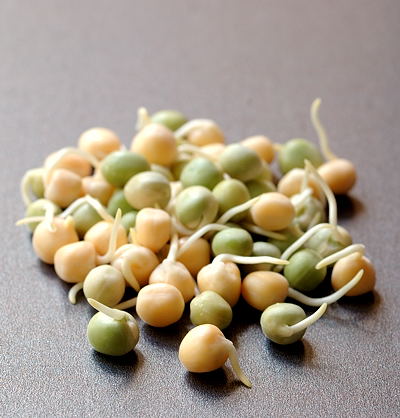
Green and Yellow Pea Sprouts ~ for This Week’s Indian Kitchen
Yellow peas split are marketed as yellow split peas. And, yellow split peas are neither toor dal nor chana dal.

Yellow peas split are marketed as yellow split peas. And, yellow split peas are neither toor dal nor chana dal.
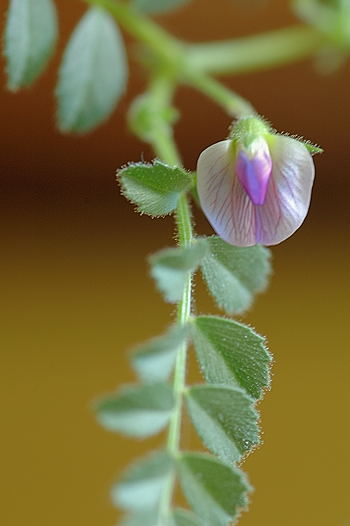
I often get asked via comments and email, to recommend cooking utensils and products. I am extremely particular about the products that I buy for my kitchen. I wasn’t sure my taste is your cup of coffee, so I was reluctant all these years. Now, I have decided to take up the challenge. Mahanandi Selections, the shopping suggestions series is going to be a new one on Mahanandi and features products that I have at my home or would like to have in my kitchen.
I hope you find this new series interesting and useful.
(Ponganalu/Paniyaram/Uniyappam Pan)
Product Features: Cast-iron aebleskiver pan with 7 slots for creating Ponganalu, Paniyaram and Pancake puffs. Preseasoned with vegetable oil formula and ready for immediate use. Cast-iron surface heats slowly and evenly to prevent burning. Nonstick, rustproof finish. Cleans easily; hand wash only. Includes long handle and opposite helper handle. The impressions are 3 1/4″ in diameter and 1″ deep.
Product Reviews: Click Here.
Ships from and sold by Amazon.com.
Sale Price: $19.99 (Reduced from 31.99).
Eligible for FREE Super Saver Shipping on orders over $25.
Traditional Recipe Ideas with Cast-iron pan:
Ponganalu ~ From Andhra Pradesh, India
Spinach Ponganalu with Sarapappu ~ From Andhra Pradesh, India
Kuzhi Paniyaram ~ From Tamilnadu, India
Ravva Unniyappam (Sooji Pancake Puffs) ~ From Kerala, India
Sweet Unniyappam ~ From Kerala, India
Deep Fried Unniyappam ~ From Kerala, India
Danish Pancake Puffs with Mango Sauce
Danish Doughnuts
During peak tomato season, when tomatoes are at their best and prices are low, my mother, Rajeswaramma would prepare this tomato pulusu. With ripe tomatoes, fresh coconut, and toasted coriander seed seasoning, tomato pulusu is nothing but taste buds tingling tomato love.
While picking tomatoes for tomato pickle, I found this precious looking tiny tomato (shown in the photo). I guess it belongs to one of those heirloom varieties. It looked so pretty and different. I did not put it in the pulusu. I photographed it and ate it like that, adding little sugar. Tasted good!
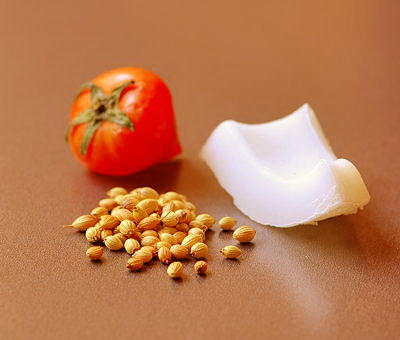
Recipe:
Cut and cook:
Rinse 8 ripe tomatoes and cut them to large pieces.
In a saucepan, heat a teaspoon of ghee. Add and toast the popu or tadka ingredients (cumin, mustard seeds – a pinch each). When seeds start to splutter, add the tomato pieces. Stir in chilli powder, salt and turmeric to taste or quarter teaspoon each. Mix and cover with a lid and cook on medium high for about 10 to 15 minutes, stirring in-between.
Blend and Add:
While the tomatoes are cooking, in a spice grinder, take 3 tablespoons of fresh grated coconut, add a tablespoon of toasted coriander seeds. Also 2 cloves and half inch piece of cinnamon stick. Grind to fine consistency.
Add this paste to the cooking tomatoes. Stir the mixture together and gently press the softened tomatoes with the back of the spoon to mush them. Add about half cup of water. Mix and taste it for spices and adjust the salt and chilli levels to your liking. Cover the pot with a lid and simmer on medium-low for another 10 to 15 minutes. When the pulusu starts to become thick, then turn off the heat.
Serve the tomato pulusu piping hot with chapati, puri or rice with little bit ghee drizzled on.
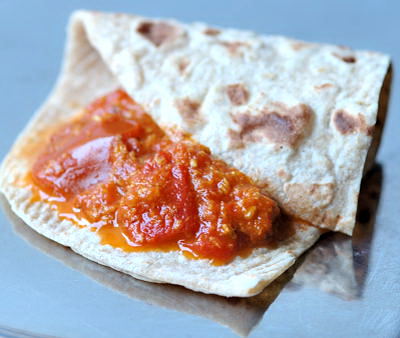
I’ve been experimenting different recipes with Rosematta rice (the terracotta colored rice variety from Kerala, India).
In addition to the traditional steam-cooked Rosematta rice, I’ve made Rosematta pongal and Rosematta idly so far. Everything turned out excellent. Rosematta truly brings wholesome and wholegrain rosy goodness to a meal. The Chocolate Lady seems to agree with me. Check out her Rosematta rice and cashew matar meal combination.
One another recipe I wanted to try with Rosematta is vegetarian congee. Congee or ganji is little amount of rice simmered in large quantities of water to a creamy porridge. At its most fundamental, congee is rice water, flavored with buttermilk or coconut milk, chilli and salt. For today’s meal I dressed up the Rosematta congee with vegetables and Yuba (The thick cream that forms on the top of simmering soy milk is removed in layers, sun-dried and rolled into sheets). Add few pieces, the yuba will soak up the saaram, become soft and taste like milk meegada. A neat protein delicacy popularized by Buddhist monks, I gathered.
Sometimes you have to spend hours in the kitchen to make a remarkable meal. Sometimes it becomes effortless, today is one such day. Rosematta and yuba together made a hearty vegetarian congee. We loved our soothing, simple supper.
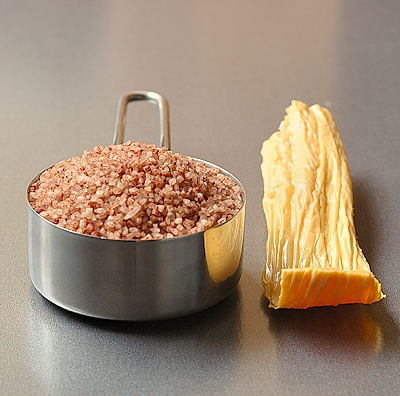
Recipe:
1 cup – coarsely milled (broken) Rosematta rice
½ cup yuba (bean curd sticks, broken to one-inch length pieces)
½ cup each – cut pieces of carrot and ridge gourd (turai, beerakaya)
6 cups water and 1 cup milk.
1 teaspoon peanut oil or ghee
Seasoning:
6 fresh curry leaves
1 tablespoon ginger juice (Grate or crush the ginger & squeeze.)
1 teaspoon – coarsely crushed black pepper
½ teaspoon salt or to taste
In a big pot, heat ghee or oil.
Add and saute curry leaves, black pepper, carrot and ridge gourd pieces 2mts.
Add the yuba, Rosematta rice, water and milk.
Stir in salt and ginger juice.
Bring to a boil, then lower the heat, cover and simmer for about 30 minutes.
When the congee becomes thick and creamy, turn off the heat.
Serve warm. Tastes great with pickle.
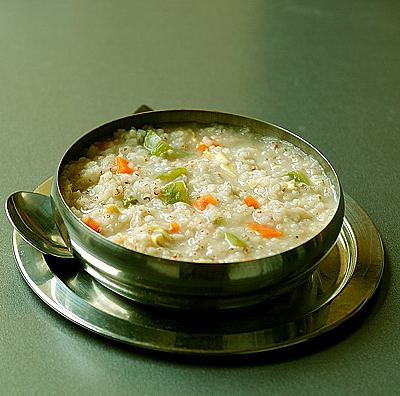
Notes:
Homemade Yuba ~ Recipe
Rosematta rice ~ Broken variety purchased at Apna Bazar, Bellevue
Yuba (Bean Curd Sticks) at Uwajimaya or also at Chinese grocery.
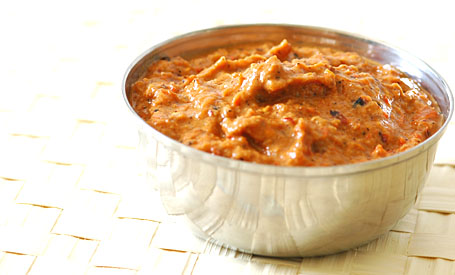
Of all different colored bell peppers (capsicums), I like the red ones. Red bell peppers are matured green bell peppers and when bell pepper ages, not only the color but the flavor also changes. They become sweet, which is a surprise. Usually maturing into red signals the more fierce kind of flavor in vegetables, but here they mellow.
This favorite chutney of mine is prepared by roasting red bell peppers, onion and dried red chillies and by blending them including peanuts, jaggery and tamarind juice. The result is one of the flavorful and easiest Bharath-inspired chutneys you will ever try. Tastes superb with all the breakfast items, like idly, dosa, upma and also with rice, chapati or as a spread and dip for snack items.
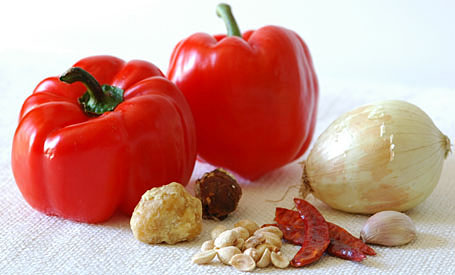
Recipe:
Cut to big chunks:
2 big red bell peppers
1 medium sized onion
6-8 dried red chillies
1 garlic clove
Saute:
Heat about 1 to 2 tablespoons of peanut oil in a skillet.
Add and Saute the cut vegetables and dried red chillies on high heat. The vegetables should be very well browned and soft. Remove them from heat and allow to cool.
Meanwhile Soak and Roast:
Small Lime sized tamarind in half-cup of warm water for about 10 minutes. Or microwave for 30 seconds – This is to soften the tamarind, so it can blend well.
Roast half-cup of peanuts till golden and remove skins. Store-bought un-salted, roasted peanuts are fine too.
Blend, in a blender or in a mortar using a pestle:
All the roasted vegetables
Tamarind, along with the water it soaked in.
Half cup of roasted peanuts
½ tablespoon of powdered jaggery
¼ tsp of salt or to taste
Grind them together to coarse puree, without adding any extra water.
Remove to a cup and serve with your favorite breakfast/lunch/supper items.
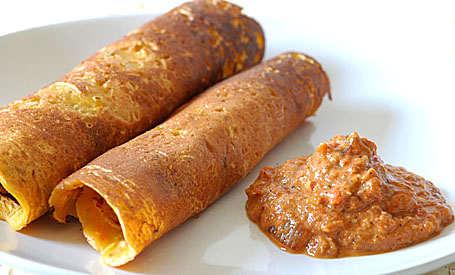
This recipe was first published on Mahanandi on June 20th, 2006.
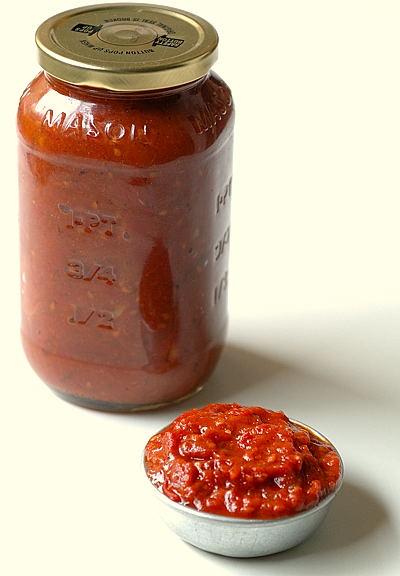
A new grocery shop has opened in the neighborhood recently and they had a grand opening sale on some items. Good looking tomatoes, still on the vine were advertised for 49 cents a pound. The deal was irresistible and I bought 20 pounds thinking of making tomato pickle.
There are mainly two ways of tomato pickle preparation that I am familiar with. The sun-dried method and the stove-top simmering method. Both produce excellent tasting pickles of different personalities. The first one needs super bright sunshine. It’s hot here in Seattle since last week, but it is no way near Nandyala hot. So, I decided on stove-top simmering method. Mainly, it’s fail-proof and produces tomato pickle of high quality that’s ready to eat as soon as it’s done simmering.
Like in any pickle preparation, the ingredients quality matters a lot for tomato pickle also. Tomatoes that actually taste like tomatoes with thin skin and little bit under-ripe are the best. Traditionally, tomato seeds and skin are included in pickle for that special texture and extra something they bring to the end experience. Sesame oil, tamarind, fenugreek, red chilli powder, iodine-free salt, asafetida, garlic, and fresh curry leaves – total eight ingredients are needed, which can be purchased at Indian grocery shops for low prices.
Surrounded by all natural ingredients, simmered tomatoes in tomato pickle sure make a bold, declamatory statement on taste buds. Sweet, sour, salty and spicy, the rich taste of tomato pickle is an addictive one. We particularly like it with upma, pongal, and yogurt rice. Also as a spread on chapatis and on toasted bread.
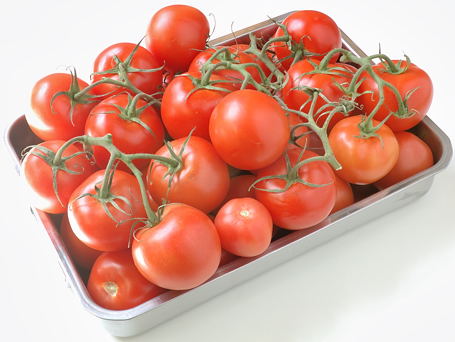
Recipe:
Tomatoes: 25 tomatoes rinsed and wiped dry with a clean towel. Coarsely chopped – about 15 cups.
Tamarind: 3 index finger-length tamarind pods soaked in half cup hot water and juice extracted. Or about ¼ cup thick tamarind pulp (added to enhance the tomato’s sweet-sourness quality).
Sesame oil (non-toasted variety from India, not the Chinese type) – ¼ cup
Red chilli powder – ¼ cup
Iodine-free salt – ½ cup
Fenugreek powder – 1 tablespoon
For Popu or Tadka:
2 tablespoons sesame oil
2 sprigs curry leaves, about 15 fresh curry leaves
10 garlic cloves – thinly sliced lengthwise, (like sliced almonds)
¼ teaspoon asafetida (inguva)
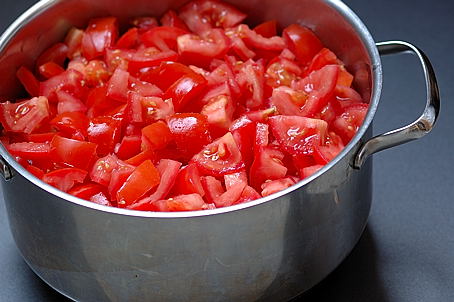
In a big, non-reactive pan, add and heat sesame oil (¼ cup). Add the tomatoes to hot oil. Also the red chilli powder, salt and tamarind pulp. Mix and cover the pot. Cook on high heat, stirring in-between for about 30 minutes. Tomatoes will be mushed down and you will be seeing lot of tomato juice trying to lift the pot lid and splash the counter-tops.
At this stage, add the fenugreek powder. Reduce the heat to medium, partially cover the pot and simmer until the tomatoes become thick but spreadable like jam. It takes easily an hour. Fine-tune the balance and adjust salt and chilli levels to your liking. The next step will be adding the toasted popu or tadka ingredients.
In a skillet, heat the sesame oil (2 tbs) until a garlic piece tossed in it sizzles. Lower the heat to medium. Add the garlic first and then the curry leaves. Toast to pale gold color. Turn off the heat. Stir in asafetida. Mix and immediately add the toasted skillet contents to the tomato pickle.
Stir so that everything gets well combined. Simmer, uncovered for about ten minutes, gently mixing. Turn off the heat and let the pickle cool. (Do not cover the pot.)
Fill the completely cooled tomato pickle in a clean glass jar with a tight lid. It stays fresh for a month, and stores very well even without refrigeration.
Enjoy!
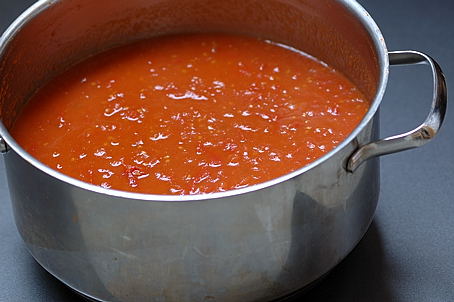
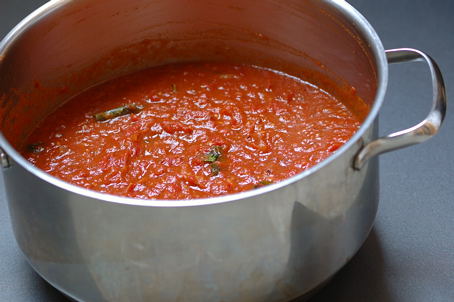
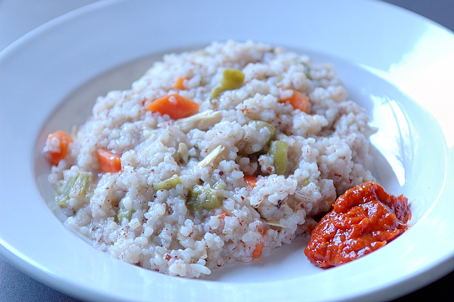
Recipe Source: Amma, Nandyala
If you are planning to make it with regular salt, reduce the quantity by couple of teaspoons, also adjust the salt level to your taste.


Food Blog Talent:
Adhi Potoba ~ Food From Pune, from Applebee’s Country




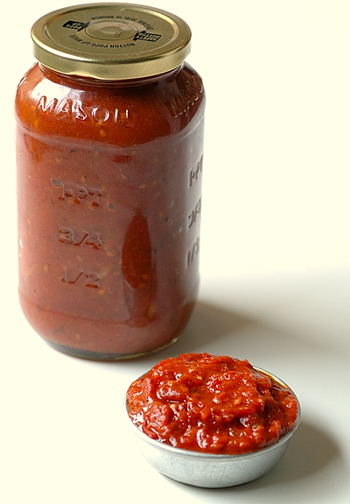
Thanks all for your interest in tomato pickle. Here is the Recipe:
The Art of Making Tomato Pacchadi
If you think you have benefited in some way, by using any of Mahanandi’s recipes and you want to show your appreciation by donating some money, here is Mahanandi’s Cause.
“Provide the Seeds to Sow”. Spread the word and donate.
Diminished appetite and constant need for something cool, it’s that kind of hot day here in Seattle.
To revive the sweltering spirits, I had to prepare something pleasant. Sweet and juicy, in rich mahogany color, Washington state’s own beautiful bing cherries came to the rescue. Few cherries halved, pitted and mixed with yogurt, then refrigerated for half an hour. Preparing chilled cherry yogurt at home is a simple process with delightful results.
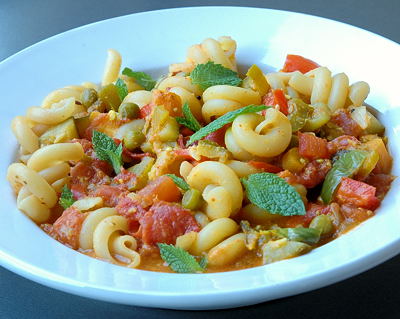
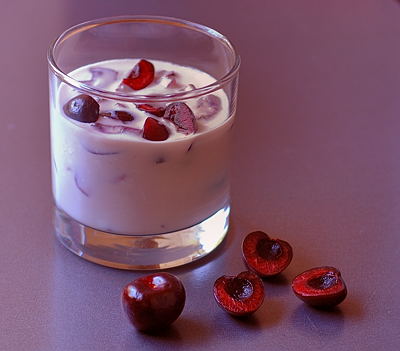
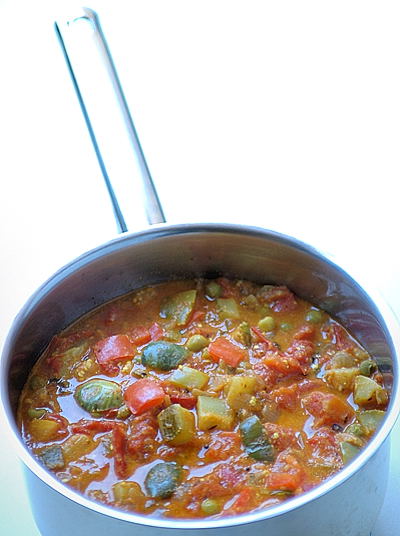
When it comes to international cuisine, French cuisine ranks among our favorites. Then again, we are devotees of Tibetan, Thai, Mexican and Italian … well you get the picture. But back to French food, if we may. So delighted are we of the new Pixar animated movie, we decided to recreate one of our favorite French recipes at home. Cheeseless and cheerful ~ The Ratatouille.
Dictionary defines Ratatouille as “A vegetable stew, usually made with eggplant, tomatoes, zucchini, peppers, and onions, seasoned with herbs and garlicâ€Â. Ratatouille, Pulusu, Kurma or Subzi …different names in different languages but the underlying wisdom is the same. Isn’t it? When vibrant and fresh looking vegetables are available, the recipe served will make happy people happier and comforts those who aren’t. Really, we don’t have to do much in order to make a miraculous meal.
The India inspiration is addition of poppy seeds. When added to bobbling vegetables in the pot, the powdered poppy seeds will bring sweet aroma and subtly enriches the ratatouille in a typical Indian way.
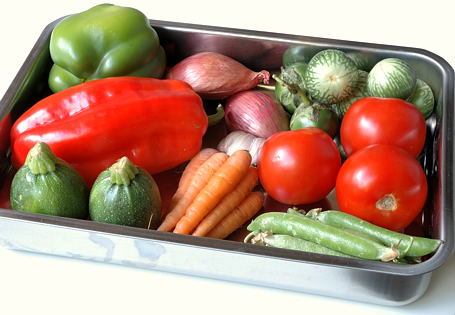
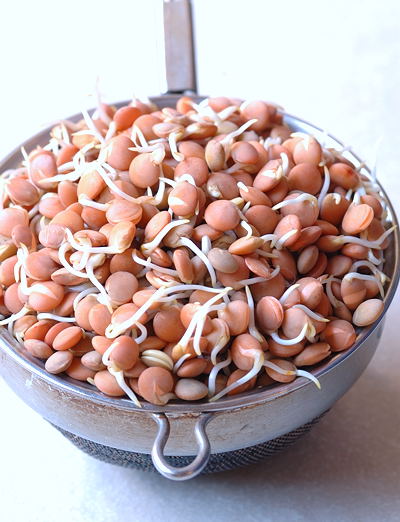
Whole masoor dal is quick to sprout. Just few hours soak-time in water and few hours hang-time in a cotton cloth under the warm rays of the sun. That’s about it. Like the sensitive student that staunchly strives to deliver a stellar performance, masoor dal swiftly transforms itself from drab brown to dazzling shade of orange-brown within a day. Truly impressive.
This is the first time I did the sprouting thing with whole masoor and I found the process undemanding and the sprouts pleasant tasting. I remember from science classes that the sprouting process turns the starches in lentils and legumes into more digestible sugars. Whole masoor dal provides a textbook example. Prominently perceptible sweet taste, crisp texture, delicate and a delight, masoor dal sprouts are a must try for sprouts connoisseurs. I totally recommend.
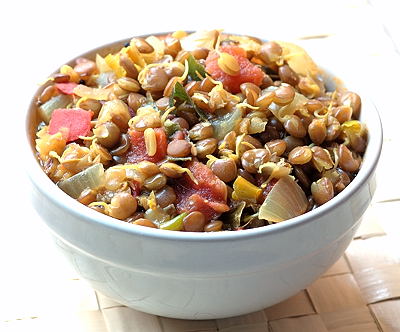
This is what I’ve prepared with sprouted masoor dal. A light and easy, low-calorie stew with a taste that humbles even the contrived sprouts-cynic. That’s how I felt after the meal.
Recipe:
1 teaspoon peanut oil
2 each – curry leaf sprigs and garlic cloves, coarsely chopped
¼ tsp each – cumin, mustard seeds and asafetida(inguva)
1 onion, 2 tomatoes and 3 green chillies – finely chopped
2 cups sprouted masoor dal
¼ tsp each – turmeric and salt, or to taste
1 lime – juice squeezed
Few Springs of Fresh Coriander
In a big saucepan, heat the oil until a curry leaf tossed in it sizzles. Lower the heat to medium. Add the curry leaves and the garlic to cook to pale brown. Toss in cumin, mustard seeds and asafetida. When seeds start to jump, add the onions, tomatoes and chillies. saute for few minutes until they soften.
Stir in sprouted masoor dal, turmeric and salt. Add about a cup of water. Bring to a boil and reduce the heat and simmer until the dal reaches fall-apart stage, about 10-15 minutes. Add lime juice and few sprigs of fresh coriander leaves. Mix and serve warm. It tastes good on its own. No rice or chapati is needed to enjoy the sprouted masoor dal and that makes it a perfect meal for calorie-conscious.
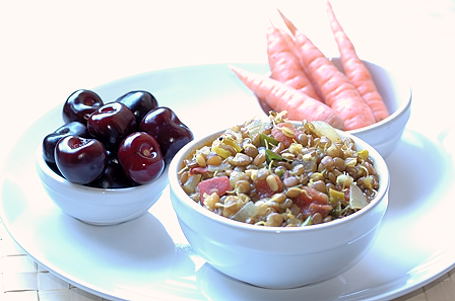
Notes:
Whole masoor dal (brown) and Split masoor dal (Red) can be bought at Indian groceries and also at natural food stores in bulk bins here at US.
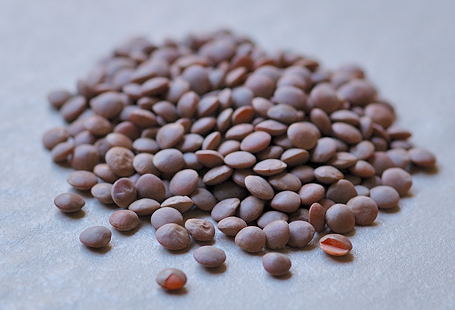
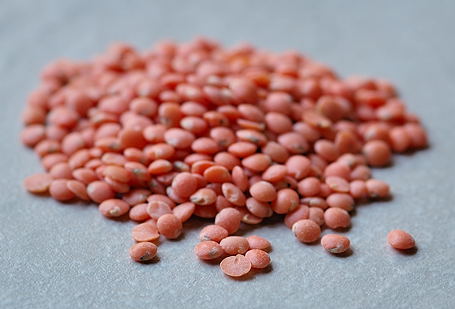
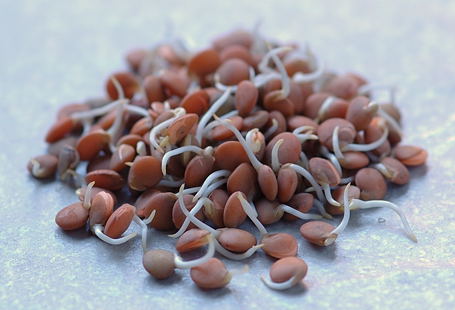
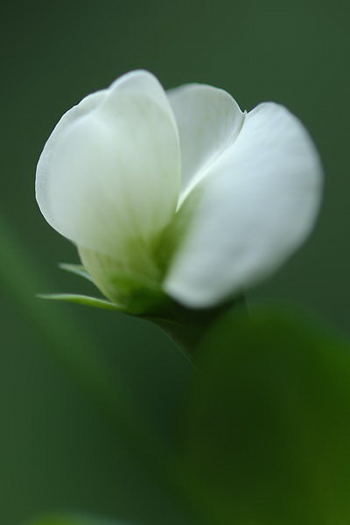
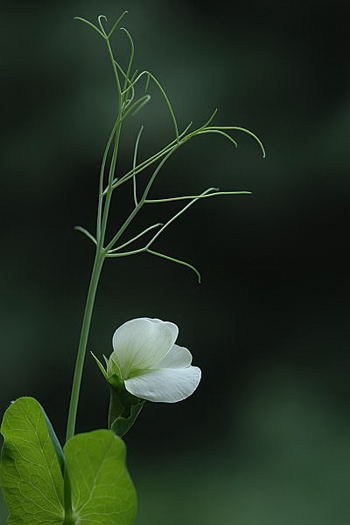
Flowers in Food Blog World:
A Rosie Delight ~ Gulkhand
Mango Flowers and More ~ From Bharat
Onion Flowers
Radish Flowers